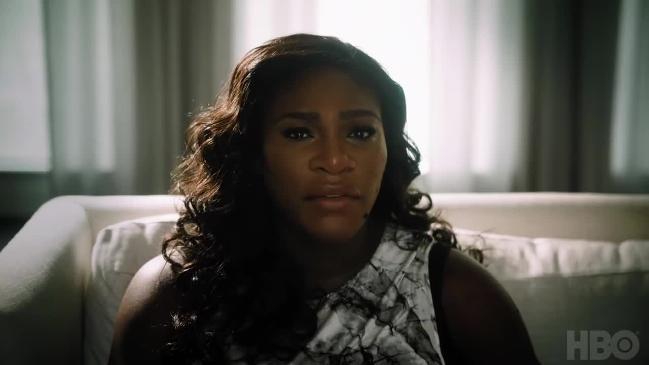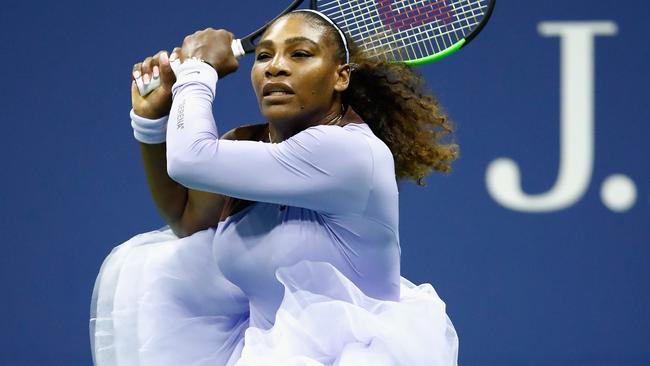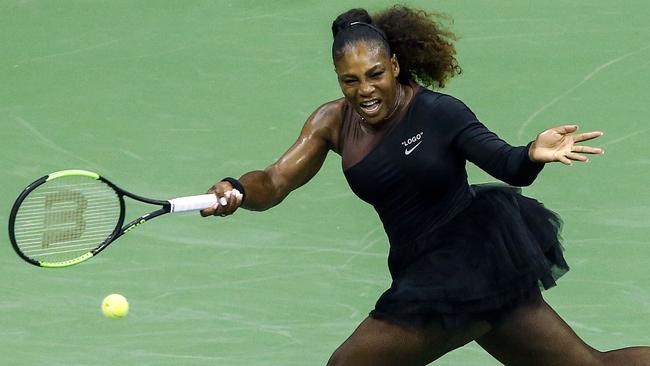Serena’s outfits aren’t the problem with tennis
SERENA Williams and her fashion have been the talk of the US Open this year. But after decades of going up against the establishment, why shouldn’t she have fun, asks Bianca O’Neill.

Rendezview
Don't miss out on the headlines from Rendezview. Followed categories will be added to My News.
WHEN you take on a giant of the game like Serena Williams, expect to get owned in a big way.
This week, controversy circled the tennis pro and new mother following an interview with the French Tennis Federation president Bernard Giudicelli when he slammed Williams’ on-court outfit choices.
“I think we sometimes went too far,” Giudicelli said of Williams’ famous black “Wakanda” catsuit, worn at the 2018 French Open. “ … It will no longer be accepted. You have to respect the game and the place.”
“Respect” is an interesting word to use in this context, considering that at the time, Williams had explained to the media that the catsuit wasn’t entirely a fashion choice. “I’ve had a lot of problems with my blood clots,” she said referring to the health condition led to her having an emergency Caesarian, surgery for blood clots in her lungs and left her on her “death bed” at one point. “God, I don’t know how many I’ve had in the past 12 months. I’ve been wearing pants in general a lot when I play, so I can keep the blood circulation going.”

However, this week, her response to Giudicelli’s out-of-touch remarks about her catsuit was a remarkably measured comment that Grand Slams “have a right to do what they want to do.” It came as a surprise to many people, who, outraged on her behalf, bombarded social media with commentary about “policing women’s bodies”.
Andy Roddick said the ban was “so dumb and shortsighted it hurts.”
Even Billie Jean King weighed in, saying that what women wear to work should be their own business, and calling for more respect of Williams’ talent.
However, no one should be surprised that Williams swatted away the controversy like it meant very little to her. The simple fact is that Williams is used to it by now.
Since Serena Williams (and even her sister Venus) started playing the game, they have been slut-shamed, body policed and ridiculed for their race on numerous occasions.
As a teen, Venus was famously penalised when a few beads slipped out of her braided hair, with the official calling it a “disruption”. When Serena dared to wear a diamond tennis bracelet on court in 2002, the Washington Post suggested she could be confused “for a working girl of a different sort.”
The sisters have had comments made about their “bulging muscles”, “defensive-back physique”, and “masculinity” follow them relentlessly, despite their domination of the game.
Beyond that, their race has been the source of continuous abuse (Serena refused to play the Indian Wells Masters from 2002-2014 due to racist taunts she received in 2001), and their early years living in Compton (a city in Los Angeles with a high Hispanic and African-American population and poor reputation for violence) the source of some discomfort for tennis elitists.

But even with all of the pushback both sisters have been forced to subsume into their stratospherically successful careers, this week has shown that in some respects, the official bodies of tennis are still as strong as ever. Wimbledon continues its strict white-outfits-only tradition to this day (one that finds its history in the clothing colour choice of the aristocracy), while Alize Cornet was hit with a code violation for changing her shirt on court at the US Open when she discovered it was on the wrong way, while Roger Federer and Novak Djokovic both appeared shirtless on court at the same tournament, but with no violations received. How’s that for a double standard?
True to form, Serena has hit back at the hypocrisy of her sport not by complaining, but by protesting in her own unique way, taking to the court wearing, yes, a traditional skirt-and-top combo, but not one any tennis fan had ever seen before.
Designed in collaboration with Nike and newly-minted Louis Vuitton designer Virgil Abloh, Williams brought a tutu to centre court, and won in straight sets.
According to the traditional tennis set, Williams is courting too much attention with her fashion choices and taking away attention from the game. But others, like myself, have never been more interested in the game because of it.
Hitting back at countless attacks on her gender and lack of femininity with a tulle tutu and fishnets designed by a black designer for the best female black tennis player the world has ever seen? Now that’s game, set and match.
Bianca O’Neill is a Melbourne-based writer.
Originally published as Serena’s outfits aren’t the problem with tennis


